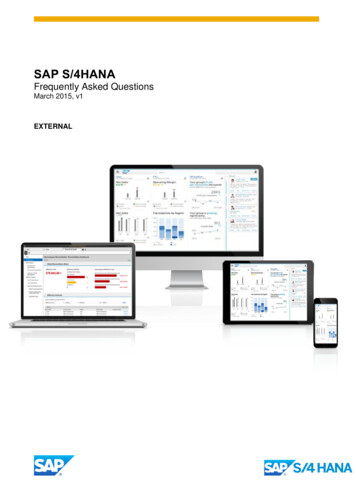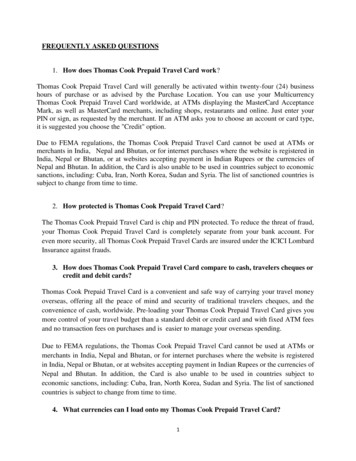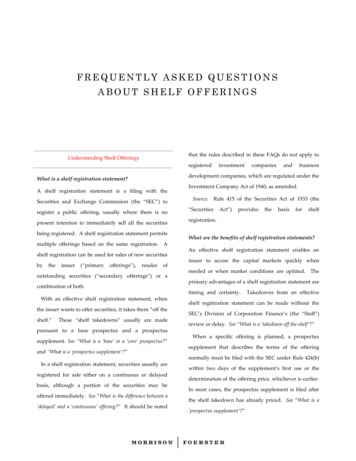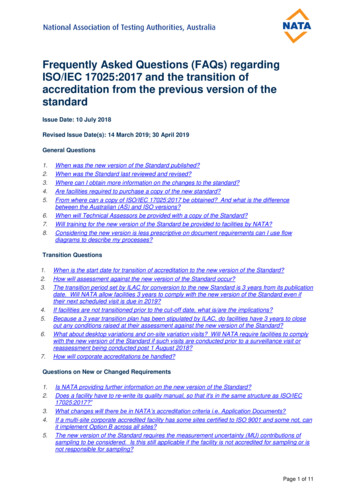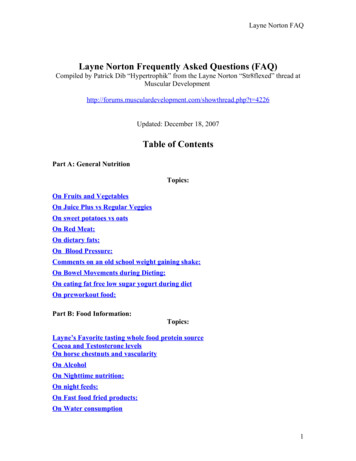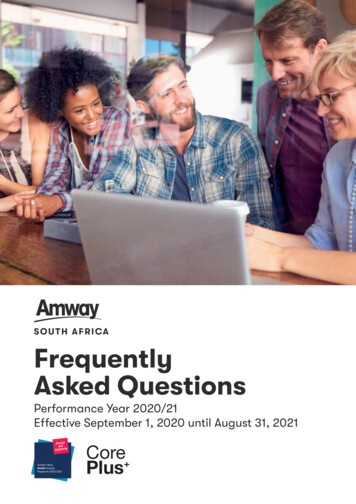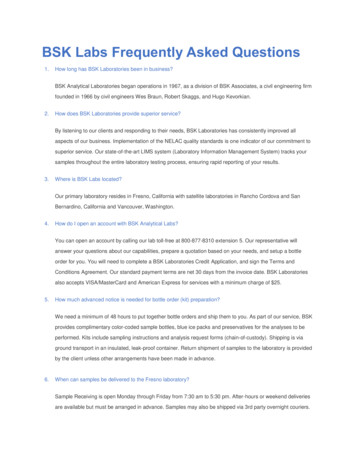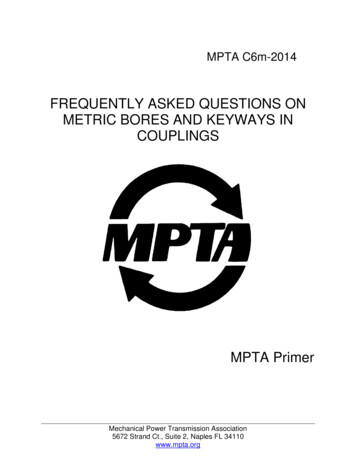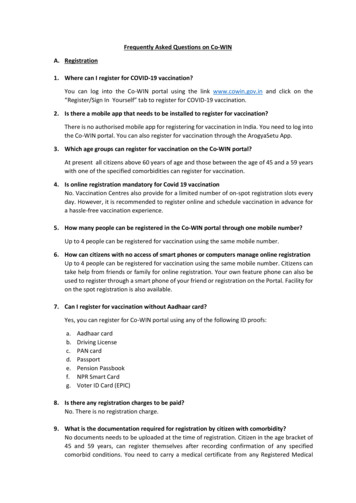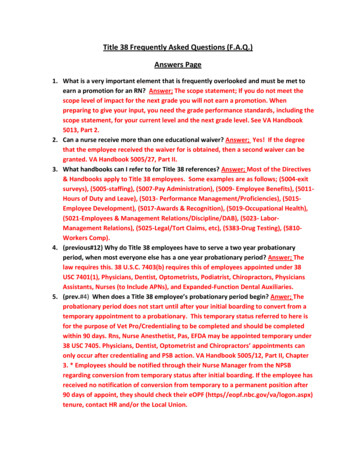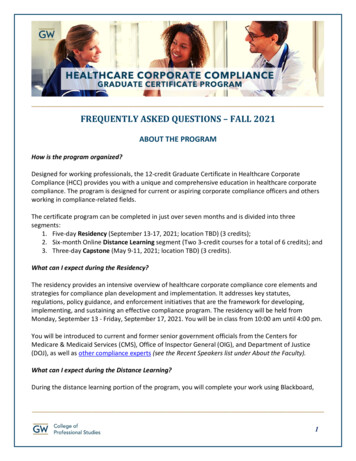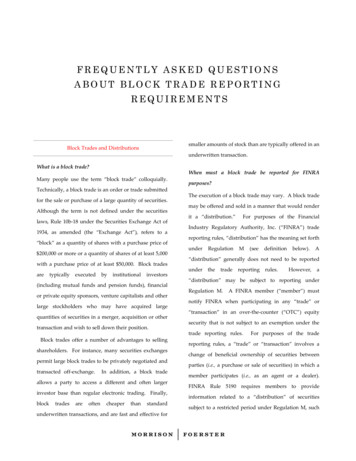
Transcription
FREQUENTLY ASKED QUESTIONSABOUT BLOCK TRADE REPORTINGREQUIREMENTSsmaller amounts of stock than are typically offered in anBlock Trades and Distributionsunderwritten transaction.What is a block trade?When must a block trade be reported for FINRAMany people use the term “block trade” colloquially.purposes?Technically, a block trade is an order or trade submittedfor the sale or purchase of a large quantity of securities.Although the term is not defined under the securitieslaws, Rule 10b‐18 under the Securities Exchange Act of1934, as amended (the “Exchange Act”), refers to a“block” as a quantity of shares with a purchase price of 200,000 or more or a quantity of shares of at least 5,000with a purchase price of at least 50,000. Block (including mutual funds and pension funds), financialor private equity sponsors, venture capitalists and otherlarge stockholders who may have acquired largequantities of securities in a merger, acquisition or othertransaction and wish to sell down their position.The execution of a block trade may vary. A block trademay be offered and sold in a manner that would renderit a “distribution.”For purposes of the FinancialIndustry Regulatory Authority, Inc. (“FINRA”) tradereporting rules, “distribution” has the meaning set forthunderRegulationMshareholders. For instance, many securities exchangespermit large block trades to be privately negotiated andtransacted off‐exchange.In addition, a block tradeallows a party to access a different and often largerinvestor base than regular electronic trading. rwritten transactions, and are fast and effective fordefinitionbelow).A“distribution” generally does not need to be stribution” may be subject to reporting underRegulation M.A FINRA member (“member”) mustnotify FINRA when participating in any “trade” or“transaction” in an over‐the‐counter (“OTC”) equitysecurity that is not subject to an exemption under thetrade reporting rules.Block trades offer a number of advantages to selling(seeFor purposes of the tradereporting rules, a “trade” or “transaction” involves achange of beneficial ownership of securities betweenparties (i.e., a purchase or sale of securities) in which amember participates (i.e., as an agent or a dealer).FINRA Rule 5190 requires members to provideinformation related to a “distribution” of securitiessubject to a restricted period under Regulation M, such
as the determination of the restricted period seRegulation M, whether members are relying on thelimitations under Rule 10b‐18 under the Exchange Act“actively‐traded securities” exemption and pricingprovides a safe harbor from liability for marketinformation.1manipulation when an issuer or its affiliated purchaserengages in a block repurchase of shares of the issuer’sIs there any helpful guidance under Regulation M forcommon stock.determining when a “distribution” exists?Regulation M was adopted by the Securities andSpecial selling efforts and selling methodsExchange Commission (the “SEC”) in order to curtailActivities that may constitute “special selling efforts andmanipulative practices by distribution participants andsellingprovides some guidance for determining whether areceiving higher compensation than it ordinarily woulddistributionareceive for normal trading transactions or dealer“distribution” is defined as “an offering of securities,activity, using sales documents, conducting a road showwhether or not subject to registration under thein connection with a transaction or holding investorSecurities Act, that is distinguished from �mightincludeabroker‐dealertrading transactions by the magnitude of the offeringThe guidance under Regulation M is useful because itand the presence of special selling efforts and sellingnarrows the broad scope of the definition of anmethods.”underwriter by limiting the situations in which thatMagnitude of the offeringdefinition is implicated. The definition of a distributionis based on facts and circumstances, and can lead to theIn determining the “magnitude of the offering,” the SECwill look at the number of shares being sold, thepercentage that these shares represent of the total sharesoutstanding of that issuer, the issuer’s public float andthe average trading volume of the issuer’s securities.The SEC has provided guidance regarding tradingvolume, as it relates to determining whether atransaction is deemed a “distribution.” For example,Rule 144 (“Rule 144”) under the Securities Act of 1933,as amended (the “Securities Act”), imposes a volumelimitation requirement which provides a safe harbor forsimilarly structured transactions being considered adistribution in one case but not in another. For thisreason, a broker‐dealer must analyze each situation notonly on its merits, but also in the context of its regularactivities. If a broker‐dealer is concerned about whetherits activities constitute a “distribution,” the broker‐dealer may find it prudent to conduct diligenceactivities and enter into an agreement with its client,providing for the making of representations andwarranties and requiring the delivery of opinions ofcounsel.sales of securities that would otherwise be deemed aWhat is a “distribution” in the context of a block trade?1 FINRA members are required to submit these Regulation Mnotices electronically through FINRA’s “Firm Gateway”system. For more information regarding Regulation M, see our“Frequently Asked Questions About Regulation M” availableat: .pdf.Morrison & Foerster LLPGenerally, trading activities for a block may not rise tothe level associated with a “distribution” under federalsecurities laws. Shares that are purchased and sold in a2
block trade are often placed quickly by an investment(pursuant to a registration statement) transaction. Asbank’s block trade desk and executed for a standardused in the Securities Act, an “issuer” is defined to“dealers’ fee,” without the use of sales documents andinclude the issuer itself and its affiliates or controlwithout special selling efforts.persons.Further, these sharesIn executing a block trade on behalf of anoften are sold to relatively few institutional buyers whoissuer or on behalf of an affiliate, a broker‐dealer shouldalready may have expressed an interest in acquiringconsider the factors discussed above and may wish tostock should a block become available. However, understructure its activities in a manner intended not to be acertain circumstances, block trades may be considered a“distribution.” However, if a broker‐dealer is executing“distribution,” which has the effect of exposing thea block trade on behalf of a third party (unrelated to thebroker‐dealer to potential liability as a statutoryissuer and not an affiliate or control person), dependingunderwriter.on the facts and circumstances, the transaction willUnder Section 2(a)(11) of the Securities Act, an“underwriter” is defined as “any person who offers orsells for an issuer in connection with the distribution ofmore likely than not be deemed to constitute a“distribution.”This broad definition of a “distribution” is fact‐specificany security.” The SEC has defined “issuer” broadly toandinclude any person directly or indirectly controlling ordeterminations on specific cases, explaining that thecontrolled by the issuer or under common control withindividual or entity in question is in a better position tothe issuer.determine its status than the SEC.As a result, activities undertaken by atheSEChasroutinelyrefusedtomakeIn addition, thebroker‐dealer on behalf of affiliates of an issuer (officers,Securities Act does not contain definitions for certain ofdirectors or greater than 10% stockholders) may raisethe other terms used in Section 2(a)(11), including thethe same concerns as those taken on behalf of the issuer.term “distribution.”Further, a broker‐dealer does not need to be engageddistribution occurs can an underwriter be involved.It is clear that only when aformally as an underwriter or placement agent in orderto incur this potential liability.The broker‐dealer’sReporting Requirementsrelationship to the transaction, the extent of its activities,and its fees, taken as a whole, will determine whether itmay be considered to be acting as a statutoryWhat are the reporting requirements for block tradesunder the exchanges?underwriter.In general, the transaction reporting requirements forThe nature of the party for whom the broker‐dealer isexecuting the block trade also may implicate eunderwriter.consideredaAstatutoryunderwriter if the broker‐dealer participates in adistribution of securities for an issuer. A “distribution”may include a private transaction as well as a publicMorrison & Foerster LLPthe New York Stock Exchange (the “NYSE”) andNASDAQ are similar.The NYSE has a generalreporting rule specifying that transactions must bereported promptly.In particular, NYSE Rule 131specifies that trades must be reported within an hourafter the close of business on the day the trade wasmade.3
The NASDAQ rules provide more detail as to theis closed are not subject to the 10‐second reportingtypes of information a broker‐dealer must provide forrequirement.equity trades.midnight and 8:00 a.m. ET must be reported byA broker‐dealer must specify theSpecifically, trades executed between8:15 a.m. ET on the trade date, and trades executedfollowing information:between the close of the relevant reporting facility and the symbol of the stock; the number of shares bought or sold; the price paid or received for such shares; the type of transaction for the reporting partymidnight or on any non‐business day (i.e., holiday orweekend) must be reported on an “as/of” basis by8:15 a.m. ET on the following business day.It is important to note that all transactions reported(buy, sell or cross); andafter 10 seconds will be considered reported late. the time of execution.For equity trades executed outside normal marketWhich party is responsible for reporting a block trade?hours, FINRA has indicated that the actual executionThe answer depends on the parties involved.price should be reported, rather than the last closingtransactions between members, the “executing party”price on the relevant exchange.must report. In transactions between a member and aInnon‐member or customer, the member is obligated toHow long after a block trade is executed must abroker‐dealer report the trade?report. The determination of market maker status forpurposes of trade reporting obligations is no longerUnder FINRA Rule 6380B, trades must be reported toapplicable.the FINRA/NYSE Trade Reporting Facility as a tradereport that is reported to and publicly disseminated byHow is the “executing party” defined?theInformationThe “executing party,” for purposes of FINRA tradeTrades executed duringreporting, is defined as the member that (1) receives annormal market hours (i.e., between 9:30 a.m. andorder for handling or execution or is presented with an4:00 p.m. ET) must be transmitted within 10 seconds oforder against its quote, (2) does not subsequentlyexecution (unless the transaction involves restrictedre‐route the order, and (3) executes the transaction. Forequity securities, in which case the trade must betransactionsreported no later than 8:00 p.m. ET on the trade date).members could reasonably maintain that they satisfyTrades executed outside normal market hours andthe definition of executing party (e.g., manuallyduring the hours the relevant reporting facility is opennegotiated trades via the telephone), the membermust still be reported within 10 seconds of executionrepresenting the sell‐side must report the transaction to(unless the transaction involves restricted equityFINRA, unless the parties agree otherwise and thesecurities executed between 8:00 p.m. ET and midnight,member representing the sell‐side contemporaneouslyin which case the trade must be reported no later thandocuments such agreement.appropriateexclusiveProcessor (a “tape” report).Securitiesbetweentwomembers,whereboth8:00 p.m. ET on the following business day). Tradesexecuted during the hours the relevant reporting facilityMorrison & Foerster LLP4
What types of transactions are excluded from theWhat information must a broker‐dealer relying on anreporting requirements?unregistered secondary distribution provide to FINRA?A broker‐dealer is not required to report to the tape theA member that would otherwise have the tradefollowing transactions:reporting obligation must provide notice to FINRA that transactionsreportedonorthroughanpart of an unregistered secondary distribution.exchange, such as the NYSE or NASDAQ; transactions that are part of a primarydistributionsecondary elyingontheunregisteredsecondarydistribution exception must provide the followinginformation to FINRA: security name and symbol;distribution such as a selling shareholder block execution date;trade or PIPE transaction;2 execution time;transactions made in reliance on Section 4(a)(2) number of shares;of the Securities Act; trade price; and members that are parties to the transaction.the acquisition of securities by a member asprincipalinanticipationofmakinganimmediate exchange distribution or exchangeoffering on an exchange; and memberAdistributions), or an unregistered secondary3 it is relying on the exception for transactions that arepurchases of securities off the floor of anexchange pursuant to a tender offer.Notice and information regarding the unregisteredsecondary distribution must be provided to FINRA nolater than three business days following the trade date.If the trade executions occur over multiple days, thenthe initial notice and available information must beUnfortunately, self‐regulatory organizations, such asprovided no later than three business days following theFINRA, do not provide a definition for many of thefirst trade date and the final notice and informationterms referenced above.must be provided no later than three business daysAs a matter of practice,broker‐dealers and their counsel should refer to thefollowing the last trade date.rules and regulations promulgated under the SecuritiesAct and the Exchange Act for further guidance.Must a broker‐dealer report a transaction madepursuant to an asset purchase agreement?In the case of a transaction that consists of both a primarydistribution and a secondary distribution, each type ofdistribution would be analyzed separately.3 In the case of debt securities, including unlisted convertibledebt securities, exempt from registration pursuant toRule 144A under the Securities Act, the sale from the issuer tothe initial purchaser does not need to be reported to FINRA’sTrade Reporting and Compliance Engine (“TRACE”), but theresale of securities by the initial purchaser to investors needs tobe reported to TRACE. All subsequent resales of Rule 144Adebt securities, including unlisted convertible debt securities,must also be reported to TRACE. TRACE reporting is beyondthe scope of these Frequently Asked Questions.2Morrison & Foerster LLPSecurities that are transferred pursuant to an assetpurchase agreement (“APA”) are not reportable if:(1) the APA is subject to the jurisdiction and approval ofa court of competent jurisdiction in insolvency matters;and (2) the purchase price under the APA is not basedon, and cannot be adjusted to reflect, the current market5
prices of the securities on or following the effective dateHow are “riskless principal” transactions reported?of the APA.A “riskless principal” transaction is a trade in which aMust a broker‐dealer report block trades made for thepurpose of creating or redeeming an instrument thatshows ownership of or otherwise tracks the naidenticalcustomerorderorderinthemarketplace, while taking on the role of principal, inorder to fill the customer order. Members can reportsecurities transferred?“riskless principal” transactions by submitting a singleTransfers of equity securities for the sole purpose ofcreating or redeeming an instrument that showsownership of or otherwise tracks the itaryReceipts and exchange‐traded funds) are not consideredOTC transactions for purposes of the trade reportingrules.Such trades are not reportable events, andreport to the tape in the same manner as an agencytransaction. Alternatively, members can submit two (ormore, as necessary) reports: (1) a tape report to reflectthe initial leg of the transaction with a capacity ofprincipal; and (2) a non‐tape (regulatory or clearing‐only) report to reflect the offsetting “riskless” leg of thetransaction with a capacity of riskless principal.4therefore are not required to be reported to the tape.Must a broker‐dealer report unregistered block trades?Must a broker‐dealer report block trades in foreignequity securities?A broker‐dealer is not obligated to report transactions inforeign equity securities if: (1) the transaction isexecuted on and reported to a foreign securitiesexchange; or (2) the transaction is executed OTC in aforeign country and is reported to the regulator ofsecurities markets for that country. Members must alsohave policies and procedures and internal controls inplace to determine whether a transaction qualifies for anexception under the trade reporting rules.Must a cancellation or reversal of a trade be reported?Yes.Unregistered block trades executed on behalf of an issuerA block trade executed on an issuer’s behalf on anagency or best efforts basis in a transaction exempt fromregistration under Section 4(a)(2) of the Securities Actdoes not need to be reported to the tape regardless ofwhether the transaction is considered a “distribution.”Unregistered block trades executed on behalf of an affiliateA block trade executed on behalf of an affiliate orcontrol person on an agency or best efforts basis in atransactionexemptfromregistrationunderSection 4(a)(1½)5 or Section 4(a)(7) under the SecuritiesA cancellation (if made on the trade date) orIn the case of agency transactions with matching orders,members can submit a single report to the tape so long as thematches occur in a single execution or single event, otherwiseeach individual transaction must be reported separately.Sequential executions (even those occurring very close in time)would not be considered a single execution or single event andmust be reported separately to the tape.5 Section 4(a)(1½), although not specifically provided for in theSecurities Act, has been recognized by the SEC and provides ahybrid exemption from registration. Section 4(a)(1½) consistsof (1) the exemption under Section 4(a)(1) of the Securities Act,4reversal (if made on a date after the trade date) must bereported by the same party responsible for reporting theinitial block trade.Morrison & Foerster LLP6
Act (“Section 4(a)(7)”)6 does not need to be reported toregistration under Section 4(a)(1½) or Section 4(a)(7)the tape if the transaction is considered a “distribution.”does not need to be reported to the tape if theIf the unregistered transaction does not constitute atransaction is considered a “distribution.”“distribution,” then the transaction must be reported tounregisteredthe tape following the procedures outlined in the“distribution,” then the transaction must be reported torelevant exchange regulations for reporting agencythe tape following the procedures outlined in thetrades, unless the block trade is effected off the floor ofrelevant exchange regulations for reporting agencythe relevant exchange, which would be the case in atrades, unless the block trade is effected off the floor ofSection 4(a)(1½) or Section 4(a)(7) transaction. A blockthe relevant e
1 FINRA members are required to submit these Regulation M notices electronically through FIN
